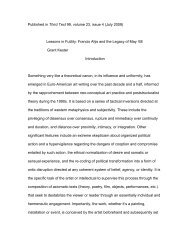Old Masters and New Lessons - Grant Kester
Old Masters and New Lessons - Grant Kester
Old Masters and New Lessons - Grant Kester
Create successful ePaper yourself
Turn your PDF publications into a flip-book with our unique Google optimized e-Paper software.
meditations on the current status of the aesthetic that seek to preserve its complexity, both<br />
culturally <strong>and</strong> politically, as a practice <strong>and</strong> a discourse.<br />
NOTES<br />
1. Friedrich Schiller, On the Aesthetic Education of Man, ed. <strong>and</strong> trans. Elizabeth M. Wilkinson<br />
<strong>and</strong> L. A. Willoughby (1796; Oxford: Clarendon Press, 1989), 219.<br />
2. Dave Hickey, The Invisible Dragon: Four Essays on Beauty (Los Angeles: Art Issues Press,<br />
1993). See also "'B' Is for Beauty," special issue of <strong>New</strong> Art Examiner 21, no. 8 (April 1994);<br />
"The Return of Beauty," special issue of Artweek 27, no. 4 (April 1996); Richard Bolton, "Beauty<br />
Redefined: From Ideal Form to Experiential Meaning," <strong>New</strong> Art Examiner 21, no. 3 (November<br />
1993): 27-31; <strong>and</strong> Wendy Steiner, The Sc<strong>and</strong>al of Pleasure (Chicago: University of Chicago<br />
Press, 1995).<br />
3. From a draft version of Peter Dunn <strong>and</strong> Loraine Leeson's essay "The Aesthetics of<br />
Collaboration." They wrote: "it has to be acknowledged . . . that in displacing the focus to other,<br />
previously under theorized <strong>and</strong> under valued powers at work—the social, economic, ideological,<br />
<strong>and</strong> wider cultural contexts <strong>and</strong> 'readings' of the art work—many valuable new insights have<br />
been revealed. But a refusal [by postmodern critics] to engage adequately with something so<br />
central to the activity of making <strong>and</strong> viewing art—the visual power or 'beauty' of the work—left a<br />
gap that enabled the transcendentalists, institutional gate-keepers <strong>and</strong> neo-Modernists to claim<br />
this ground for their own."<br />
4. Hickey, Invisible Dragon, 13-14.<br />
5. Ibid., 29, 34. According to Hickey, Robert Mapplethorpe, Andy Warhol, <strong>and</strong> Ed Ruscha<br />
"engage individuals within <strong>and</strong> without the cultural ghetto in arguments about what is good <strong>and</strong><br />
what is beautiful. And they do so without benefit of clergy, out on the street, out on the margin"<br />
(24).<br />
6. Ibid., 30, 31.<br />
7. Hickey is associate professor of art criticism <strong>and</strong> theory at the University of Nevada at Las<br />
Vegas. He was the 1994 recipient of the Frank Jewett Mather Award, presented by the College<br />
Art Association for distinction in art criticism. He describes his views as "outrageous" in Invisible<br />
Dragon, 12.<br />
8. Ibid., 13.<br />
9. Ibid., 22.<br />
10. It would seem to be the case that Mapplethorpe's images are only confrontational or<br />
transgressive for someone with little or no awareness of gay S/M sexual practices. For other<br />
viewers they might seem simply erotic, or merely banal.<br />
11. "Gorgeous Politics, Dangerous Pleasures: Dave Hickey on Beauty's Subversive Potential,<br />
an Interview by Ann Wiens," <strong>New</strong> Art Examiner 21, no. 8 (April 1994): 15.




